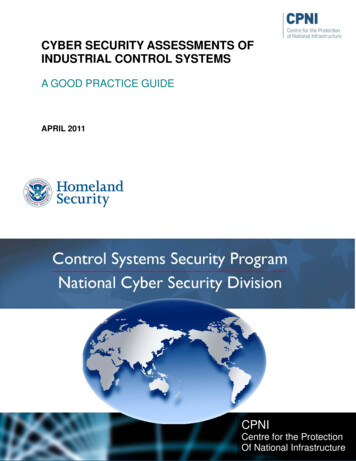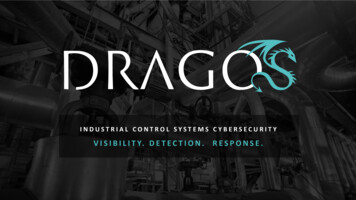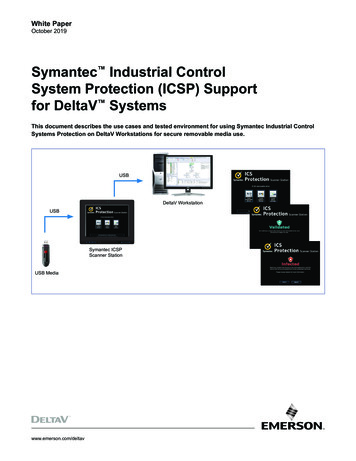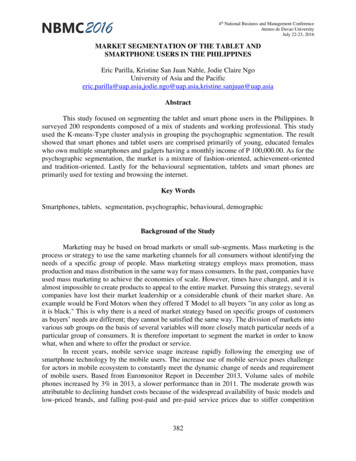
Transcription
Network Segmentation forIndustrial Control Environments
IntroductionIn 2015, there were 10 billion connected Internet of Things(IoT) devices. By 2020, the number is expected to skyrocketto 34 billion.1For industrial devices, this level of connectivity means anexpanded use of advanced analytic techniques to boostproductivity and efficiency, lower cost and downtime, andincrease profitability. Unfortunately, this also means anexpanded attack surface and greater risk of successfulcyber attacks within critical infrastructure environments.No doubt, cyber security is a must. But where to start?Start with network zone segmentation, a foundationalbuilding block of any modern industrial cybersecuritypractice. That is, so long as it’s applied in a manner thatbefits the specific needs of industrial control system (ICS)and operational technology (OT) environments. Otherwise,as connectivity continues to increase, the risk of successfulattacks will continue to rise while the efficiency andprofitability advantages of digital industrial investmentsslowly wane.
Segmentation 101: OriginsThe roots of network segmentation run deep in enterprise IT environments. What began as a way to improve networkperformance and bandwidth (through better management of the broadcast and collision domains of shared network devicesand better containment of network traffic on respective sub-networks for each workgroup) has today evolved to significantlysupport a proactive network security practice.This evolution is important because perimeter defense—which only accounts for traffic going in and out of the network—is nolonger enough. Once an attacker or malware penetrates the perimeter and gains a foothold, consequent lateral movementwithin the network is usually a foregone conclusion.The takeaway: More protection is needed inside the network, precisely where segmentation and its zone-specific policiesplay a crucial role; e.g., an accounting system zone might have one set of policies; an engineering zone, a different set.According to ISACA, a common technique to implement network security is to segment an organization’s network intoseparate zones that can be separately controlled, monitored, and protected.2ControlLimit the spread of an attackor mitigate the damage to aparticular network segment.MonitorAlert an IT team to the threat andspecific anatomy of the attack.ProtectStop attacks from spreading and furtherharming the broader network, criticalassets, and the organization at large.Proper segmentation enhances an organization’s security posture and helps harden the controls network. Without it, orwithout enough of it, successful hacker attacks can result in tremendous loss of data and corporate reputation.Now that OT networks are becoming increasingly connected, the attack surface is widening, and increased risk is likely. Butunlike in IT, OT environments have much more at stake.
Why OT network segmentation is different than IT network segmentationUnlike in IT environments, where asuccessful hack can result in data loss ordamage to a company's reputation, thestakes are higher in OT. When attackerstarget steel mills, power plants, pipelines,rail yards, or hospitals, defense is aboutmulti-million-dollar critical infrastructures,critical assets, the environment, and, mostimportantly, human safety.Still, while we know network segmentationis a fundamental component of cybersecurity, the problem remains that it’sdifficult to implement in an industrialcontrol environment.Depending on the situation, there areimpactful people, process, and technologyactions that can be instituted.01Air gapsare fadingIn the past, when systems were completelyisolated (both physically and virtually), therewas air gapping for security. Today, with theevolution of industrial systems, mobility,cloud technologies, and multi-vendorenvironments, everything’s changed; airgapping is no longer enough.In GE Digital's experience conducting industrialand OT site assessments, we’ve found thatnearly every site thought to be air gapped was,in fact, connected to the Internet. In short, airgaps are a security measure myth.Another myth is that all insiders aretrustworthy and competent. According to aSANS 2015 survey of industrial cyber securitypractitioners, insiders were the largestidentified source of infiltration/infection, at 25percent. Unidentified sources were the onlyhigher grouping, at 44 percent.3 A high insiderthreat and lack of visibility into other incidentsources should lead any organization toquestion relying on an air gap that may or maynot be intact.02Perimeter securityis not enoughIndustrial system devices must communicatewith one another and with other sub-systemdevices. As this creates multiple perimeterswithin OT environments, it shows how traditionalperimeter security (one protective shell aroundthe entire system) is insufficient. A better planis to give each group of systems (each with itsown unique set of security requirements) its ownunique set of granular protections.Level 5Level 4RouterEmail, Internet, etc.Figure 1 illustrates how each level can be aseparate zone, and how a zone can includea subset of elements from multiple levels.It also depicts the information flows fromlevel to level (or zone to zone) via conduits(i.e., connectivity between zones).Step one is to establish the properzones with clearly defined and enforcedsecurity policies. Step two is to properlysecure the conduits with granularnetwork traffic inspection.Enterprise networkSite business planning and logistics networkFire Level 3Level 2Level 1Level aceSensorsApplicationserverWeb uencecontrolActuatorsFire wallSite manufacturingoperation and ervisorycontrolBasiccontrolProcessFigure 1. Purdue Reference Model for Computer Integrated Manufacturing (CIM)Fire wallCell/area zone
03IT segmentation technologiesdo not fit OT environmentsWhether it's an entire level or a collection of cross-levelelements, each zone has its own perimeter. While this might,at first blush, make typical IT segmentation seem like a goodstrategy, we know it’s not. Why? Because we also know ITtechnologies simply weren’t built to work in OT environments.Even if VLANs and routing were to work in OT environments,they still fall short in terms of security efficacy. While effectivein directing network traffic and containing it within designatedzones, these technologies do not provide insight or enforcesecurity policy for network traffic. Specifically, they can’t answer: Does the traffic contain malware? Does the network traffic use a legitimate command for anunauthorized, malicious, or otherwise dangerous purpose?Traditional segmentation mechanisms using VLANs or routingcan become very complex, very fast. In order to configurenew IP addresses and ports that accommodate VLANs andIP subnetting, an OT environment must be brought downor configuration must be scheduled during a maintenancewindow. From a cost perspective, the required downtimeand/or equipment reorganization makes this an impracticaloption. What’s more, the complexity increases the risk ofmisconfiguration and employee error while the necessaryoverhead could overwhelm an operations team alreadystrapped for OT security skills and resources. Is a command issued to leverage a device vulnerability tolaunch an attack?If these issues weren’t enough, it’s also important to considerhow automation vendors may dictate specific layer-2 andlayer-3 designs. Any new network segmentation can falloutside the supported reference architecture and, thus, bedisallowed. Bottom line: Traditional IT-style segmentation isnot feasible for deep zoning of industrial systems.At best, a limited number of next-generation firewalls might beable to identify a few OT protocols associated with a data flow,but that’s about it. This level of visibility cannot detect wrongfulcommands or harmful payloads. Simply detecting that thereis an OT protocol doesn’t make anything actionable from asecurity perspective.VLANs and RoutingIT FirewallsTo secure and segment network traffic, many would recommendIT firewalls. Though IT firewalls may offer network security andsegmentation capabilities, they’ve been designed to inspect ITprotocols, not OT protocols. Essentially, this means IT firewallscannot see what’s happening on an OT network and canneither act on commands or payloads nor interpret context tounderstand whether a packet or set of packets is authorized.
Ideal segmentation for ICS environmentsEasy virtual zoning without OT network reengineeringZoning with deep OT protocol inspectionFor OT environments, a network segmentation solution must enable easy zone-levelseparation in a centralized manner. Any requirement to physically move equipment for propersegmentation is not only impractical, but out of the question. Critical devices are bulky and/orremotely located. A solution must instead be able to segment a network virtually or logically,even in instances where equipment resides at different sites.To properly filter and inspect network traffic across zones, a solution must understand thecommunication languages of industrial environments, namely the relevant OT protocols(Modbus, DNP3, OPC, and others). That’s step one: protocol recognition.Additionally, a solution needs to feature an intuitive graphical user interface (UI) such thatsegmentation can be completed, as necessary, remotely. The UI should include a simpledrag-and-drop feature that easily enables OT personnel of any skill level—and withoutextensive IT security training—to accomplish zoning objectives.Lastly, the segmentation process cannot require OT network re-engineering orreconfiguration. Any changes that would take the network offline or cause disruptions toproduction are unacceptable.Figure 2. Zoning exampleThe next step is deep protocol inspection. It’s critical to consider the fact that legitimateprotocol commands can be used for illegitimate purposes. Indeed, whether a networkbased exploit, denial of service attack, or an insider assault, each uses legitimate trafficin illegitimate ways. Deeper scrutiny into the full context of each data flow can help give aglimpse into malicious intent or accidental misconfiguration and, therefore, must extend toeach packet bit (every “0” and “1”) to include the header (source and destination addresses)and the payload (commands such as read, write, reset, power on, power off, etc.).Purposeful or not, incorrect execution of control commands can lead to dire consequences andcause physical damage to a network’s critical assets. Therefore, a solution must be able to makedecisions to allow, alert, or block OT network traffic based on the full context of the packet.This includes the protocol, industrial application, command, addressing, sessions, normal vs.anomalous or malicious traffic, and more.
Zone-specific OTsecurity policiesZones must enforce policy specifically created for a particularOT environment. Each network has its own unique combinationof standard and proprietary protocols, multi-vendor industrialcontrol systems, and various locales around the world. Securitypolicy must conform to the network, and not the other wayaround. In other words, you can’t afford to make changes to thenetwork for the sake of zoning when policy should be transparentand seamless to deploy.To build a security policy tailored for your OT environment, lookfor a solution that includes a baselining capability to record allOT network traffic and determine what normal traffic shouldlook like so that each zone can be protected from malicious oreven anomalous behavior (as represented by employee error ordevice misconfiguration). In addition, choose a solution that canautomatically create security policies from the baseline.Ideally, the solution needs to understand the full context ofOT protocols, be able to complete virtual zoning remotely andcentrally, and enforce security policy that’s easily customized foreach unique OT environment.Take the first steptoward ICS networkresilienceNetwork segmentation is a core building block of a maturecybersecurity profile. In fact, it will do more for reliability andsafety than almost any other available security measure.With GE Digital technology, system operators and integratorscan define and implement segmentation that is specific toOT environments. They will be able to isolate systems intofunctional groups with similar security requirements andestablish proper zones and conduits. This type of isolationnot only makes unauthorized access and exploitation ofcritical devices much more difficult, but it can also helpminimize the impact should a breach occur.Contact GE Digital for an evaluation of your operationaltechnology environment, and learn how to best segmentyour network to enhance your security posture and promotesafer nter/documents/glossary/cybersecurityfundamentals /documents/glossary/cybersecurityfundamentals glossary.pdf
About GEGE (NYSE: GE) is the world’s Digital Industrial Company, transforming industry with software-defined machinesand solutions that are connected, responsive, and predictive. GE is organized around a global exchange ofknowledge, the “GE Store,” through which each business shares and accesses the same technology, markets,structure, and intellect. Each invention further fuels innovation and application across our industrial sectors.With people, services, technology, and scale, GE delivers better outcomes for customers by speaking thelanguage of industry.Contact InformationAmericas: 1-855-YOUR1GE (1-855-968-7143)gedigital@ge.comwww.ge.com/digital 2017 General Electric. All rights reserved. *Trademark of General Electric. All other brands or names are property of their respective holders.Specifications are subject to change without notice. 05 2017
According to ISACA, a common technique to implement network security is to segment an organization’s network into separate zones that can be separately controlled, monitored, and protected. 2 Proper segmentation enhances an organization’











